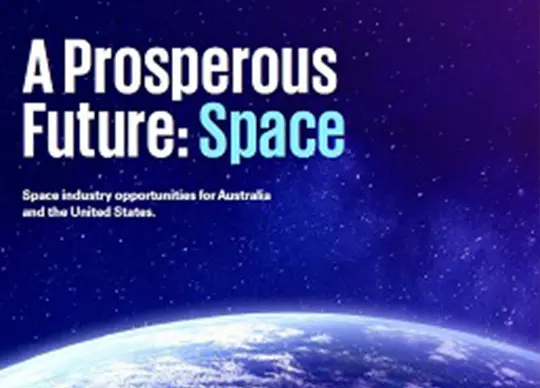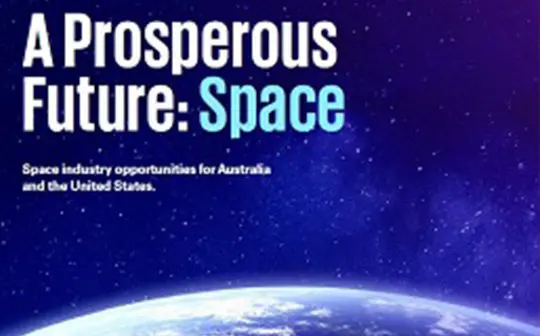
Australia could generate nearly US$400m in exports and more than 1,300 specialised, high-paying jobs within a decade by accelerating growth in space industry trade directly with the United States, a new report by KPMG Australia and the American Chamber of Commerce in Australia (AmCham) finds.
The report, A Prosperous Future: Space, notes that the space industry already presents increasing opportunities for Australia, with the Australian Space Agency targeting growth of the size of the sector to A$12bn by 2030, with some of this growth likely to be driven by US investment. But KPMG modelling indicates that with the US looking to invest and partner with Australian space companies, this growth could be increased.
April Palmerlee, AmCham CEO said, “Australia can leverage its natural and structural advantages, strong foundations in many areas of the space industry, and the relationship with the US to realise significant potential additional benefits from deeper mutual engagement. Australia can provide the United States with access to innovation, diversified supply chains, and reduction in cost of participation – and in return Australian companies will benefit from significantly enhanced export opportunities.”
Doug Ferguson, KPMG Head of Asia & International Markets said, “The size of the US space industry, measured in revenue terms, is expected to grow by 67 percent over the decade 2020-2030 from US$201bn to US$335bn, suggesting a large potential for Australian businesses to participate in the US space sector’s supply chains. In addition to export trade opportunities, further benefits will flow to Australia’s domestic economy with greater uptake of space technologies, ranging from satellite communications to improved earth observations in agriculture and mining.”
KPMG modelling looked at three scenarios – a ‘business as usual’ approach based on current market share in the space industry would see Australian exports at $157m; at continued historic export growth levels this could increase to $247m – but an accelerated trade approach sees exports rise to $394m.
In terms of capital investment, and the additional labour force to meet those increased trade opportunities, three scenarios are also envisaged.
The first scenario applies Australia’s historical share of trade to the US space industries; the second uses historical average growth rate of Australian aerospace exports to the US; and the third assumes Australia can increase its share by combining the growth rates derived from scenarios 1 and 2.
This represents growth in Australia / US trade due to increased exports in defence and security-related goods under agreements such as the recent AUKUS deal.
The modelling found that under scenario 3, Australian capital stock would rise by $434m and specialised jobs by 1,315.
Dr Brendan Rynne, KPMG Chief Economist, said: “Our report highlights the significant export potential provided by the large US market, which will be further facilitated by close security ties. In addition to increased exports, the Australian economy will enjoy additional indirect economic benefits and greater penetration of the space industry to Australia’s domestic economy will boost productivity and output, just as it has in the US.”
April Palmerlee added, “Achieving this economic win-win depends on both industry and government working co-operatively to maximise the opportunities that are presenting with ever stronger economic and security relationships. Governments have significantly increased their investment in space, with public funding for space increasing by nearly 20 percent in 2021 alone. The opportunities are huge.”
For the private sector to take advantage of this increased focus, this report identifies three key factors:
1. Leverage Australian specialisations for space technology applications
Where Australia has a known technological advantage or sector expertise that is augmented with innovations in space technology, this can provide an innovation that the US market could welcome. Areas where Australia has strong foundation and reputation include:
- Resources sector
- Remote operations and robotics
- Quantum science
2. Working with US primes is a pathway into global supply chains
Most of the leading aerospace primes from the US have a significant presence in Australia. The primes benefit from having a broad industrial base which forms their supply chain, both in the United States and for their Australian entities and a number of Australian companies have benefited from integrating with and supplying these primes. Additionally, companies that supply the primes often benefit from increased access to export, coaching and additional opportunities to qualify and flight test their hardware and software.
3. Accelerate the time taken from policy to procurement
Many Australian companies are waiting on space programs which have been announced though funding not yet available. The move from grants to contracted programs such as the National Space Mission for Earth Observation will enable capabilities to scale much faster and be export ready.
As outlined in KPMG’s 2021 introductory report, A Prosperous Future: Key industries for Australia/US collaboration, in consultation with the Australian Department of Foreign Affairs and Trade, and the US Embassy in Australia, AmCham and KPMG identified six emerging industries that will both shape the living standards of our citizens and drive the strategic competition between states: Biotech, Energy and Clean Technology, Space, Digital Economy (DE), Artificial Intelligence (AI) and Quantum Computing (QC).
In the second report, A Prosperous Future: Emerging Tech in September 2022, AmCham and KPMG conducted a detailed assessment of the current and future growth potential of the ArtificiaI Intelligence, Quantum Computing and Digital Economy industries. The purpose of this study was to gain an understanding of how trade and investment between Australia and the United States in these sectors could enable better outcomes for the two countries as opposed to ‘going it alone’.
This final report explores the space sector. The Prosperous Future project is delivered with the support of the US Embassy, Canberra.
You can read the full report here.





